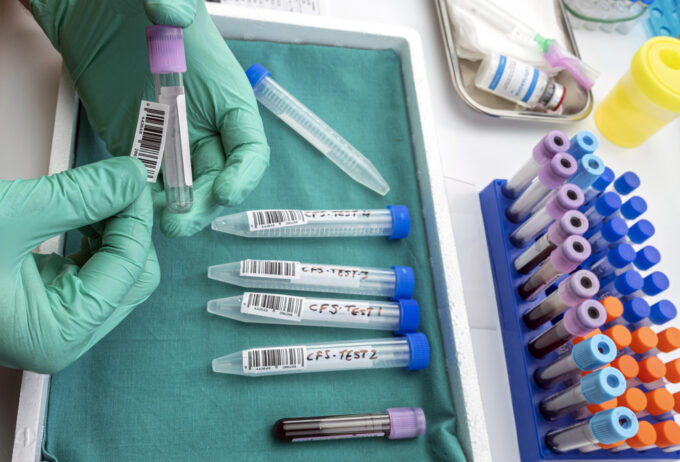Avoid dry eyes at work
Dry eyes are the most common eye disease in Central Europe. About one in five patients who consult an ophthalmologist complains of dry, itchy or watery eyes or reddened and swollen eyelids. If left untreated, there is a risk of corneal and conjunctival inflammation, but prevention is possible, even in the workplace.
The term "office eye syndrome" already indicates that frequent screen work can be a cause of dry eyes. Dry heating air, dust, cigarette smoke, allergenic substances or drafts can also be a cause. The symptoms occur more frequently during the cold season and are known among ophthalmologists as sicca syndrome or keratoconjunctivitis sicca.
Lipid layer prevents evaporation
A look at the surface of the eye shows how "dry eye" can occur. Our eyeball is protected by a watery layer (in blue in the graphic). This tear film cleans the surface of the eyeball and keeps it from drying out.
Above this is a thin oily layer (in yellow). This clear oily film is produced by the numerous tiny meibomian glands at the edge of the eye and has the task of stabilizing the tear film and protecting it from evaporation. If the structure of this lipid layer is disturbed, the tear film can no longer optimally wet the eye and the tears run off. Therefore, it comes to the paradox that of all things the dry eye can start to tear.
In addition to this hyperevaporative form (disturbed lipid layer, e.g., due to congested meibomian glands) of dry eye, a rarer hyposecretory form occurs in which tear production is decreased.

Do not play down complaints
Even though dry eyes are considered a widespread disease, the symptoms should not be trivialized. On the one hand, the risk of infection increases when germs that have entered the eye are less easily washed away. On the other hand, only an undisturbed, even tear film with an overlying oil film guarantees sharp vision. If this "coating" of the eyeball is disturbed, we see worse and contract the eye muscles. Therefore, as soon as the eyes itch or hurt, headaches and neck pain are usually not far behind. If left untreated, the cornea can also become cloudy and, in the worst case, blindness is imminent. Personal well-being, quality of life and work performance are also affected. Even anxiety disorders and depression have been observed in patients with dry eyes.
Improve air quality
Last but not least, "dry eyes" are also an occupational safety issue. Dry eyes can also be detrimental to occupational safety, particularly during monitoring tasks at the monitor or when safety goggles are involuntarily removed to rub the eyes when handling chemicals or infectious bio-substances. Employers are well advised not to dismiss their employees' eye complaints as personal (over)sensitivities, but to work with occupational physicians to find causes and solutions. The first starting point is a critical look at the quality of the air in the room and the extent to which it can be improved by regular ventilation, carefully adjusted air conditioning systems, avoidance of drafts or by air filters, air purifiers, humidifiers, etc. The first step in this direction is to identify the causes of dry eyes.

Tips for prevention and remedy
Anyone prone to dry eyes or advising others on health issues should be aware of the following advice from eye experts:
Drink enough: Our body's water balance is elementarily important for health and well-being. Drinking plenty of fluids can prevent dry eyes.
Tip: Always have a drink in sight at the workplace.
Blink consciously: A common trigger of dry eyes is that we often blink too little when working at a computer screen. This is because every blink distributes the tear fluid and also the thin oil of the meibomian glands evenly on the cornea. If the number of blinks decreases while staring intently at a monitor, the eye is no longer sufficiently moistened.
Tip: Place "Please blink" sticker on the edge of the monitor.
Take breaks from the screen: Avert your eyes from the monitor and relax, e.g. look into the distance or do small gymnastic and relaxation exercises.
Tip: Google search for "eye training" provides many suggestions.
Give your eyes a rest: If you're not typing or reading, you should close your eyes to think or concentrate.
Tip: Warm your hands by rubbing them together and then place your palms on your closed eyes and take a few deep breaths, very soothing.
It is important - in addition to glasses suitable for VDU work - to adjust one's monitor correctly. If the monitor is positioned too high, we pull our head back and tear our eyes open. It is more relaxing for the eyes and neck if the viewing direction is about 30 to 35 degrees below the horizontal.

Eye preparations rebuild the lipid layer
In addition to moistening with eye drops containing tear substitute fluids, there are also tear supplements in spray form. These liposomal (containing tiny droplets of oil) eye sprays are sprayed onto the closed eye. The ingredients then migrate to the edge of the eyelid, where they rebuild the disrupted lipid layer, restoring the natural function of the tear film. The eyelids can glide again without irritation, and the foreign body sensation disappears.
Since there are different forms of dry eye and the symptoms can also have other causes, e.g. inflammation of the eyelid margin, an ophthalmologist should be consulted before self-medication. This can clarify which preparations promise relief in the specific case.
This technical article appeared in the printed edition SAFETY-PLUS 4-2021.
You want to read all articles in this issue? Then close right now here a subscription.









